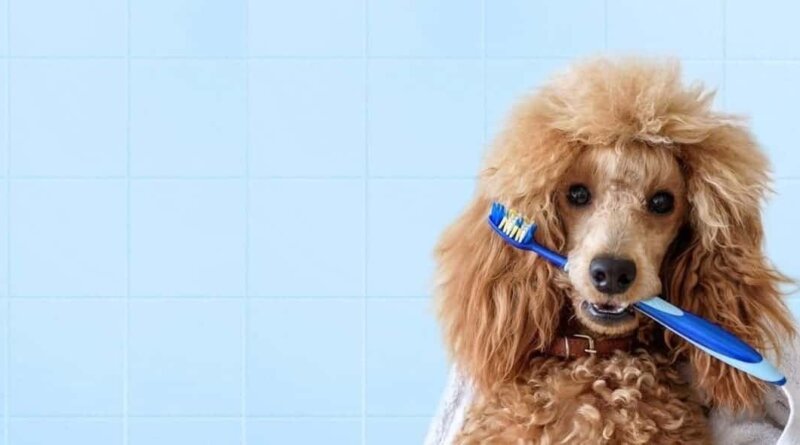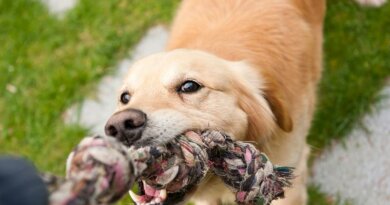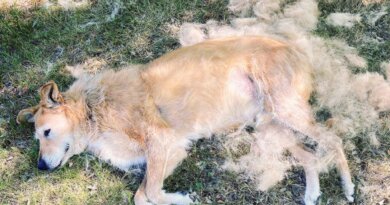Poodle Teeth: What You Need to Know To Care for Your Dog
When it comes to caring for your poodle there are plenty of things you want to keep in mind.
For example, you need to make sure you’re bathing them properly and taking them to the vet.
You also want to make sure that you’re getting them to a groomer to trim their fur and their nails.
But it’s also important that you know how to take care of poodle teeth as well. And that’s where this advice is going to come in.
Getting Started With Your Poodles Teeth

Once your poodle reaches two months of age it’s time to start brushing their teeth regularly. What’s even more important, however, is making sure that your poodle is comfortable having their teeth brushed and starting early is definitely going to help with that.
From the time they are little you can start introducing them to the toothbrush so that they are not afraid of it. Also, introduce them to the process of brushing so they know what it feels like. From there, they will learn how to stay calm and allow you to brush their teeth as needed.
If you bring a puppy home and you start them with this process early you’ll find that they are a little skittish or rambunctious at first but they will learn to relax more. On the other hand, training a fully grown dog will take a lot more time and effort because they are already set in their ways.
What if You Don’t Follow Proper Preventive Care?

If you take care of your poodle’s teeth properly and regularly you shouldn’t have dental problems or you should have minimal dental problems. On the other hand, if you’re not taking care of their teeth at home they could end up with some very serious problems. That’s because their body is always producing plaque and that plaque contributes to decay.
After three days of not being removed the plaque on their teeth starts to turn into tarter. That’s a hard substance that’s extremely difficult to remove at all, let alone with at-home dental care. And once that tartar is there it starts to destroy the enamel that protects the exterior of your poodle’s teeth. When the enamel breaks down the rest of the tooth and the gums start to break down and you start to see health problems.
You may start to see decaying teeth, periodontal disease, gingivitis, infection and even sepsis and halitosis. All of these things can happen with just a short period of not following proper dental hygiene and care.
How Often Does My Poodle Need Their Teeth Brushed?

In order to avoid these types of dental issues you’re going to need to learn how to care for your poodle properly. Taking care of their teeth means brushing them regularly and that should actually be every day. If at all possible you should be brushing your dog’s teeth daily because it takes care of that plaque before it can start to harden and it keeps their breath smelling better as well.
Now, it’s extremely difficult to find the time and energy to brush your dog’s teeth every day, so you should work out a schedule where you brush their teeth at least two to three times per week. Make sure you space out the days that you brush their teeth and you’ll be able to remove the plaque and keep the tartar at bay. Also, you only need about two minutes of brushing to get rid of that buildup.
Taking Care of Your Poodle’s Teeth Properly
There are several different stages to the process of taking care of poodle teeth, so let’s take a look at each of the different things you should be doing to help get your poodle on the right track to fresh breath and healthy teeth.
Brushing Your Poodle’s Teeth
What You’ll Need to Brush Your Poodle’s Teeth:
When you’re ready to brush your poodle’s teeth you’re actually only going to need two things, toothpaste and a toothbrush. But make sure you’re getting products that are specially designed for dogs. Human toothbrushes will not get the same results for your dog and human toothpastes can actually be harmful because of the ingredients that are in them. A product like Ortz Dog Toothpaste and Toothbrush set will help you get the job done.
This set actually comes with a two-sided toothbrush that helps you get back into the far reaches of your dogs mouth to clean even their back teeth. You also get a dog toothpaste that your pet is going to like and that you can use easily with the regular toothbrush or either of the two finger brushes that are also included. Plus, it comes with a money back guarantee so you know you’re getting something good.
When you’re ready to brush their teeth you just have to follow a few simple steps.

#1: Schedule the Time
You need to make sure that you are scheduling out enough time to get the job done when you decide to brush your dog’s teeth. Even though the brushing itself only takes a couple minutes, you still need to budget out a lot more time than that. Keep in mind that your dog may not be keen on having their teeth brushed, so you need time to get them calm and ready to go. You need a time that you can stick to routinely and also one where you’re going to feel ready to deal with any potential problems that might arise.
#2: Touching Your Dog’s Teeth
When you actually start brushing your dog’s teeth they may react negatively or uncomfortably. That’s why it’s a good idea to get them used to letting you touch their teeth before you start trying to brush them. You don’t need a toothbrush or toothpaste for this part of the process. You just need to take a few minutes to work with them and try to get them used to the process. They still may not like it (small children don’t necessarily like brushing their teeth either) but they will get used to and accept it.
Practice by playing with them and using your fingers to touch their teeth and gums gently. Keep in mind that you just want to touch the inside of their mouth and you don’t want to apply pressure or cause any sort of pain. If you have long fingernails you could hurt them unintentionally with your nails so be very careful about how you touch the inside of the mouth.
You’ll want to start with this process for several days or even several weeks before you start trying to brush their teeth with an actual toothbrush. You should start to see your dog calm down and relax a bit more when you touch their teeth and that will tell you they’re ready.
#3: Add Toothpaste
The next step is to start getting them used to toothpaste. Remember, you want to use a special dog toothpaste and never a human toothpaste. Human toothpaste contains different ingredients that can be harmful to your dog, especially if swallowed and since you’re not able to get your dog to rinse the toothpaste and spit it out, it’s going to cause damage or injury.
When you’re getting them used to the toothpaste you may want to start putting just a little in their mouth and using your finger to brush it around on their teeth. This is not a full brushing so you don’t need to worry about getting it over all of their teeth. Instead, you’re getting them used to the process and the flavor.
#4: Finger Brush with Toothpaste
There are plenty of finger brushes out there that you can use with your dog, so you want to make sure you’re going to that step before you decide to use a toothbrush. This will seem less foreign to your dog after the last few steps so they may be more accepting of it. Use a small finger brush and put a little toothpaste on it. You’ll want to work slowly and be very gentle about what you’re doing.
In this part of the process you want to actually go through the process of brushing their teeth but with a finger brush rather than a full toothbrush. At this point you’re going to spend more time on their teeth and you’re going to try to get all of the teeth rather than just brushing over a few of them.
#5: Daily Cleanings with a Full Brush
The final step is to actually brush your dogs teeth with their new toothbrush. Use the toothpaste that they’re already used to and start brushing carefully. Remember, this is still a new process for them. You want to make sure that you’re being gentle and slow about the entire process. You may not be able to brush all of their teeth with the toothbrush while you’re just getting started. You may need to work up to longer periods of brushing.
Make sure that you’re getting the toothpaste down into the bristles as well. Just putting it on top like you do for your own teeth is not going to get enough of the paste onto their teeth. Also, make sure you’re using a little bit of an angle to really get to the back teeth and the gum area.
Using Dental Chews

Dental chews are a great way to help keep your dog’s teeth clean because your dog will actually enjoy them. That’s because your dog feels like they’re getting a treat, but you know they’re getting something that can help remove plaque and even tartar. Plus, they are made with high quality ingredients that are designed to improve the strength of their teeth and help their breath smell a whole lot better than normal.
When you use these dental chews (which you can do whenever you want) your dog is definitely going to be happy and you’re going to be happy because you know they’re getting something that’s actually good for them. It’s even better than a standard treat or toy for their health and more.
Feed Quality Food

The right quality of dog food is another important part of the process when it comes to keeping your dog’s teeth healthy. The right food will help improve the strength of their teeth and help get rid of some of the harmful bacteria or plaque that’s brewing on their teeth. If you feed them something that’s high quality you also will have less plaque build-up, which is going to make the teeth brushing process a lot easier.
For example, grains, by-products, and unhealthy dishes will actually cause sticky substances to adhere to your dog’s teeth, which actually makes them more susceptible to plaque and tartar. If you’re using high quality foods that have natural ingredients they’re actually going to help keep your dog healthy all around, including cutting down on the amount of build-up.
Conclusion
Taking care of poodle teeth is an important part of the process when it comes to owning a dog. You want to make sure that you’re doing everything you can to keep your dog healthy and to make sure that they are feeling good about the whole process too. If you brush their teeth regularly, at least a few times a week, and you make sure that you’re feeding them good foods and giving them dental chews your dog is going to be much further along on the path to a healthy life.





